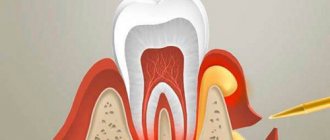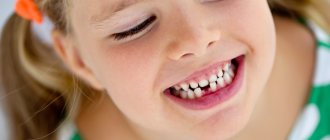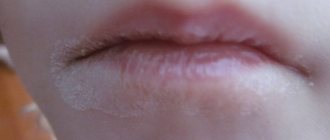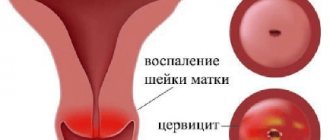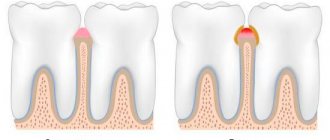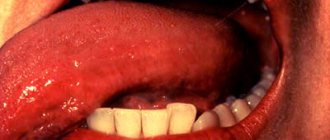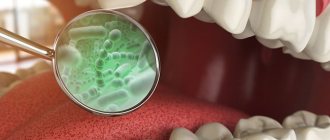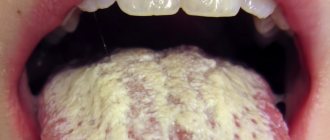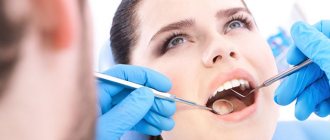ICD - deposits (growths) on teeth:
- K03.6 - deposits (growths) on teeth
- K03.60 - pigmented coating (black, green, orange)
- K03.61 - due to the habit of using tobacco
- K03.62 - due to the habit of chewing betel nut
- K03.63 - other extensive soft deposits (white deposits)
- K03.64 - supragingival calculus
- K03.65 - subgingival calculus
- K03.66 - dental plaque
- K03.68 - other specified deposits on teeth
- K03.69 - deposits on teeth, unspecified
Mechanism of plaque formation
Plaque formation on teeth begins 2 hours after brushing.
Dental plaque has the following formation mechanisms:7
1.
The surface of the tooth is coated with saliva; it contains proteins to which microorganisms attach more easily.
2. The number of microorganisms gradually increases, they produce acids and polysaccharides - high molecular weight carbohydrates that serve as food for acid-producing bacteria.
3. Subsequently, the number of bacteria increases, and the plaque structure becomes stronger. And acids destroy tooth and gum tissue.
Methods for detecting plaque
To determine the quality of home hygiene, you can use solutions of dyes: erythrosine, basic fuchsin, bismarck brown fluorescent sodium. These dyes do not have a pathological effect on the enamel or the oral mucosa. Special tablets are widely used.6
Directions for use: Chew 1 tablet thoroughly and then rinse your mouth with water. What is colored is plaque on the teeth.
It is recommended to use the tablets for children over 6 years of age.5
Contraindication for use is individual intolerance to the constituent components of tablets or solutions.
The influence of dental plaque on the development of periodontal diseases
Periodontal tissue is the tissue that holds the tooth in the jaw. If you remove at least one of them, the mobility of the tooth increases, which ultimately leads to its loss.
In 80% of cases, the leading role in the occurrence of periodontal pathology belongs to dental plaque. Of course, there are a number of factors (iatrogenic effects on the periodontium, for example, braces; occlusal trauma, malocclusion; malnutrition; stress; chronic diseases of organs and systems) that contribute to the occurrence of periodontal diseases.2
Plaque microorganisms and their toxins damage the epithelium and cause irritation, which leads to connective epithelial damage and inflammation.
Endotoxins (waste products of gram-negative bacteria) are aggressive; they increase capillary permeability, disrupt cell metabolism, which leads to necrosis. In response to this, the body produces many antibodies (proteins to destroy dangerous cells and viruses) and enzymes that destroy periodontal tissue. And due to the high amount of antibodies, periodontal tissue weakens its protective functions, which allows bacteria to easily destroy them.
The most common microorganisms found in dental plaque are Actinomyces, Actinobacillus, Bacteroides, Eikinella corrodens, Fusobacterium, Vielonella recta, Treponema denticola, Capnocytophaga.8
Tartar
Tartar is mineralized plaque on teeth.
More often it is located on the crown of the tooth, i.e. above the gum. But if the periodontal tissue is destroyed and the gum moves away from the tooth, the root is exposed and the tartar is already below the gum.
It is assumed that subgingival calculus is formed from components of blood serum, since it does not have contact with saliva.2
The different topography of these types of tartar suggests a different mechanism for their removal.
- Supragingival calculus is removed using hand instruments and scalers
- Subgingival calculus is often removed surgically to allow better visualization of the approach.
The second horror story about dental hygiene is toothless
Now I’ll tell you a horror story about how you can end up losing your teeth.
Let's come up with an average male hero. Well, let’s say we have the character Vasya. And let our dear Vasily not brush his teeth.
And he doesn’t brush his teeth for a day or two. Food remains between the teeth and in those places where we clean and cannot reach, but this Vasya does not do even that. Slowly the tooth becomes overgrown with soft and hard plaque.
The problem arises: how to start monitoring dental hygiene?
If you do not start solving the problem, the process begins to develop as follows.
Do you know when oxidation occurs in the oral cavity? Hard plaque goes deep under the gum and decomposes. Remains of food remain under the gum for a long, long time. This dental plaque, these microorganisms - they actually already live under the gums and feed on everything “delicious”. The products of their vital activity, and this is nothing more than acid, oxidize the environment in the oral cavity.
In turn, this has a negative effect on the enamel, it is destroyed and becomes susceptible to caries, and not only caries, but also all other pathologies.
And now there is bad breath
I don’t think it’s pleasant for Vasily to walk and communicate, because there is such a thing as halitosis. Halitosis is bad breath. It can be of gastrointestinal origin, of course - this is when there are certain diseases of the gastrointestinal tract, and a person has such an unpleasant odor from his mouth (you can’t call it a smell, rather it’s more of an evaporation). Or this is due to the fact that our Vasya does not brush his teeth at all.
I don’t know how Vasily kisses girls either. No, well, maybe the girl is the same - yes, but history is silent about this. Well, okay, we won’t scold Vasily, he needs to somehow start taking care of his oral cavity more often. So that later there will be no problems with courting girls 
And finally, our Vasily developed tartar
Tartar disrupts the dentogingival attachment and also disrupts the cement of the tooth root, and due to this, the tooth is kept in the socket and the tooth becomes mobile. There are two possible outcomes: either it’s periodontitis or it’s periodontal disease.
The peculiarity of hygiene in patients suffering from periodontal disease with teeth susceptible to the cariogenic process is a separate conversation. In patients suffering from periodontitis, of course, everything is much worse. Teeth become loose and eating becomes more difficult. As a result, teeth are lost one by one.
Individual oral hygiene
Individual oral hygiene is the removal of plaque by the patient himself at home using various hygiene products; in other words, it is home brushing of teeth. Home hygiene does not always remove all dental deposits, but proper hygiene will reduce the amount of plaque and bacteria.
Toothbrush
The toothbrush should be soft.
For many, this is surprising, because most are accustomed to using a brush of high and medium hardness - but this is wrong. Using a soft brush will initially seem like poor hygiene, but there are benefits to it as more time will be spent brushing and hygiene will be done properly.
Thanks to a soft toothbrush, the risk of injury to enamel and gums is reduced. The toothbrush should have smooth, thick bristles.3,13
Mono-tuft toothbrush
Allows you to thoroughly clean the gingival sulcus area.
The mono-beam cleans areas that are inaccessible to a regular brush. A mono-beam brush is convenient to use when the gag reflex is pronounced. This brush is a must-have hygiene product; you can use it to clean your teeth without using toothpaste.3,14
Rules for using a mono-beam brush:
- Hold the monotuft brush vertically
- Place the brush so that the bristles are around the gum line
- We move the beam from one tooth to another along the gum line with soft stroking movements.
- We don't put pressure
- We repeat the same steps on the inner surface of the teeth.
Dental floss
Dental floss should be safe and not injure the gums when used correctly.
Dental floss can be classified by color, thickness and fiber structure. Classification of dental floss:
| CLASSIFICATION | A COMMENT | ||
| classification: | Shape:3 | a comment: |
Superfloss - threads with different thicknesses (used in children with braces, and in adults with implants). |
| classification: | By processing: | a comment: |
|
| classification: | According to the presence of impregnations: | a comment: |
|
| classification: | Based on holder availability: | a comment: | Flosssticks are dental floss with holders. Disadvantages of floss sticks:
Dental floss should be used after every meal to prevent food from getting stuck in the teeth.10 |
Rules for using dental floss:
1. It is necessary to unwind about 40 cm of thread from the roll and cut it using the built-in cutter.
2. The ends of the thread are wound around the middle fingers.
3. The middle part of the thread is clamped with the index finger and thumb so that 5 cm remains
4. The thread is threaded between the teeth and moved with sawing movements without strong pressure.
5. The tooth is grasped from all sides and gently brushed from top to bottom.
6. The used piece of thread is wound around the middle finger (can be washed with water), the next gap is cleaned with a clean piece
7. The floss is threaded through the same gap to clean the adjacent tooth.
When should you start flossing?
- Up to 2 years of age, floss is not used - until baby teeth completely erupt. The exception is when the child has tight contacts between the front incisors.
- 2.5-6 years – the period of “contact caries”. Its occurrence is associated with densification of the dentition. A toothbrush cannot fully clean the interdental spaces. It is necessary to use dental floss. Closer to 6 years, you can use a ribbon thread or an irrigator.
- From the age of 6 – brushing teeth with floss becomes an obligatory ritual; the child can be taught to practice independent hygiene
Dental brushes
It is advisable to use a brush every time after eating.
One procedure is enough; too sudden and repeated movements can injure the gums. Terms of use:
1. It is necessary to insert a brush between the teeth closer to the gum
2. The brush should lie at a slight angle relative to the gum
3. It is necessary to carefully move the brush so that it goes right through between the teeth.
4. Strong pressure and pressure should be avoided, the brush should pass easily
5. At the end, you can carefully remove the brush and repeat the procedure with all teeth
Dental floss removes food debris between the teeth, and dental brushes clean them of plaque. At first, it will be difficult to use dental brushes, so it is recommended to start with the smallest sizes and gradually increase them. When you first start using brushes, your gums may bleed.4
Tongue scraper
Plaque on the tongue may indicate the accumulation of pathogenic bacteria that are located in the papillae of the tongue.
These bacteria, in turn, can:
- migrate to teeth and cause caries
- cause bad breath
- accumulate on the gums, causing inflammation
- negatively affect overall oral health
- yellow coating on the tongue does not look aesthetically pleasing
We must not forget about tongue hygiene, since pathogenic microorganisms can get on the teeth and nullify the effect of brushing.
It is not recommended to brush your tongue with a toothbrush or the back of it. The best cleansing effect can be achieved using a tongue scraper. Scrapers come in metal and plastic. It is recommended to use plastic ones, as they do not injure the tongue.3
Irrigator
A device for cleaning plaque and food particles between teeth. Hygiene is carried out under the pressure of a water jet. An irrigator cannot replace dental floss. Thanks to the irrigator, hydromassage of the gums occurs and blood circulation improves.
PROTECTIVE FUNCTIONS OF THE ORAL CAVITY
The oral cavity occupies a special place in the life of humans and animals. Performing numerous functions, the oral cavity is constantly exposed to influences that can lead to disruption of the integrity of its integument. There is no doubt that the oral cavity is a unique complex of analyzers, thanks to which the body receives comprehensive information about the food, drinks and rejected substances. Moreover, some researchers (V.A. Polyantsev and others) call the oral cavity a dental analyzer . This analyzer, when faced with factors that could harm the body, as well as damage the tissues of the oral cavity, formed a complex of behavioral adaptive protective reactions aimed at destroying and releasing agents from the digestive canal that threaten the health of humans and animals.
At the same time, diseases of the dental system do not occur on their own. After analyzing a huge amount of material, the researchers came to the conclusion that there is a close connection between diseases of individual specific teeth and internal organs. In this case, each individual tooth is assigned the role of an indicator of diseases of certain organs.
Thus, the liver is projected at the level of the lower canines. The condition of the pancreas can be judged by the small molars, and diseases of the joints of the legs can be judged by the incisors of the upper and lower jaw. Caries of wisdom teeth indicates that careful attention to the heart is required, and the condition of the fangs can suggest the presence of a pathological process in the lungs.
Consequently, depending on which tooth suffers from caries, one can judge which organ needs help (Fig. 33). But if the same tooth hurts not for the first time, then this indicates that the disease has gone too far, and you should urgently seek advice from a therapist or a “narrow” specialist.
Meanwhile, dental damage itself, especially the presence of caries, can be the cause of persistent migraines. In this case, the tooth itself may not hurt, although it is affected by caries.
But what is happening to our internal organs can be judged not only by the condition of the teeth, but also the gums. In particular, in the presence of gastric or duodenal ulcers, periodontal disease usually develops.
Sometimes patients complain to the dentist about unbearable toothache, but the doctor does not find any serious pathology. In these cases, the cause of such toothache can be sudden jumps in blood pressure in patients with hypertension, or attacks of angina pectoris.
At the same time, the oral cavity has a number of protective mechanisms that protect not only the maxillofacial apparatus, but also the internal organs from damage.
The role of saliva. Rejected and damaging objects include solid and granular substances, salts, acids, alkalis, too hot or cold objects and products, and mechanical influences. Typically, under these conditions, increased salivation occurs, which is protective in nature and contributes to the preservation of oral tissues. Thus, strong irritation of mechano-, chemo-, thermo- and nocereceptors leads to abundant salivation. At the same time, saliva contains a lot of water and few enzymes, which helps to quickly remove rejected substances from the oral cavity and normalize the temperature of incoming products or liquids.
Oral fluid contains proteins, enzymes and alkaline salts (sodium chloride, potassium chloride, etc.), which gives saliva buffering properties and helps neutralize the acids and alkalis of rejected substances.
It is known that along with food, a large number of microorganisms enter the digestive canal, including pathogenic ones, which can cause the development of pathological processes. There are more than 400 types of bacteria in the human mouth, some of which can cause infection of the gums and underlying bone tissue. In the oral cavity there are quite favorable conditions for the development of microflora - the presence of food debris, the slightly alkaline nature of saliva, humidity, and optimal temperature. Microorganisms make up up to 70% of dental plaque. It is estimated that 1 mg of dry plaque mass contains up to 250 microbial cells, and 1 ml of saliva contains more than 108 microbes. The distribution of microbes and viruses in the oral cavity is uneven - most of them are located in periodontal pockets, folds of the mucous membrane and in the interdental spaces.
The role of pathogenic microflora in gum lesions is extremely important. Particular attention should be paid to the development of a disease in the oral cavity such as periodontal disease. Inflammation of the gums, in which they become sensitive to various irritants and bleed, is the first stage of periodontal disease, which affects millions of people. At least half of school students suffer from it.
If this disease only affected the gums, then it would not be so bad. The trouble is that as the diseased gums peel away from the teeth, deeper and deeper pockets are formed into which the infection penetrates, corroding the bone tissue. At the same time, the teeth do not sit tightly in their sockets, and ultimately the person loses them. But at the same time, periodontal disease can accelerate the development of other diseases in the body or aggravate their course. In recent years, new information has been obtained about the relationship of this disease with serious, sometimes fatal diseases, even such as myocardial infarction.
How is protection from pathogenic microflora carried out in the oral cavity?
When studying the microbial flora of the oral cavity, it was found that it is relatively stable, preventing the spread of pathogenic microorganisms. This stability is largely determined by the composition of saliva and the presence in it of compounds that have bactericidal and bacteriostatic effects.
An important role in maintaining homeostasis in the oral cavity belongs to the enzyme lysozyme ( muromidase ). The bacteriolytic effect of this enzyme is associated with the destruction of muramic acid in the wall of some bacteria, as a result of which its permeability changes and the contents diffuse into the environment.
lactoperoxidase has a bactericidal effect (participates in the lysis of gram-negative bacteria) due to the formation of bactericidal aldehydes and the incorporation of strong oxidizing agents (halogens) into the bacterial membrane.
Myeloperoxidase , an enzyme that promotes lipid peroxidation and leads to the death of bacteria, was found in saliva
Lactoferrin competes for iron ions with bacteria and, if the latter have a developed cytochrome system, leads to a bacteriostatic effect.
mucin takes part in the destruction of bacteria , which promotes the attachment of a significant number of bacteria to exfoliating epithelial cells. The oral fluid washes away the exfoliated cells, and after swallowing the saliva, they are digested in the stomach. In the acidic environment of gastric juice, simultaneous death of bacteria is observed.
In the oral fluid there are b-lysines , which penetrate here from the blood due to passive diffusion. They affect the cell membrane of bacteria, leading to their lysis.
Saliva contains interferons , which are able to suppress the replication of a variety of viruses and also have antitumor properties.
Saliva contains broad-spectrum proteolytic enzymes
The presence of lithium ions, cyanides and other elements also leads to the death of microorganisms.
Antibodies are of particular importance in protecting the oral cavity. is found in oral fluid . Its content in saliva is significantly higher than in serum. SIgA is synthesized locally by plasma cells formed from B lymphocytes, concentrated mainly in the submucosal layer, under the influence of interleukins secreted by Th2. Its main feature is resistance to proteolytic enzymes in saliva, as well as proteolytic enzymes secreted by some bacteria. SIgA is capable of binding exotoxins released by various microorganisms. Relatively small molecules that penetrate the surface of the gastrointestinal tract are able to stimulate the local synthesis of SIgA, which prevents the subsequent introduction of antigens by forming complexes with them on the membrane. In addition, SIgA has pronounced antibacterial activity, which is associated with the ability to agglutinate bacteria, limit their reproduction, and prevent attachment to the epithelium, without which the pathogenic properties of pathogens are not realized. In addition, SIgA has pronounced virus-neutralizing activity.
The importance of SIgA in oral immunity is evidenced by the fact that individuals with a defect in this immunoglobulin experience frequent inflammatory diseases.
Serum IgA, IgG and IgE are also found in saliva , which play an important role in preventing the development of infectious diseases. IgG can be secreted in small quantities by plasma cells of the oral mucosa. As for IgE, it, like serum IgA, enters saliva from the blood by passive diffusion.
Finally, it should be noted that saliva contains components of the complement system ( C3, C4 ), which play an important role in the activation of phagocytosis, as well as stimulating reactions of cellular and humoral immunity. It is believed that complement components enter saliva from the bloodstream through the periodontal sulcus.
Despite such powerful anti-infective and anti-inflammatory protection due to the function of the salivary glands, the oral cavity is not guaranteed against the penetration of pathogens of various diseases into the body.
Of considerable importance in protecting against pathogenic microorganisms, toxins and other damaging agents are special barriers that help protect cells of organs and tissues from contact with damaging agents. The function of such barriers in the oral cavity is performed by the epithelium of the mucous membrane.
The tongue has a particularly powerful barrier function, since it is covered with keratinizing stratified epithelium. The gums are covered with single-layer epithelium, and therefore their barrier function is relatively weakly expressed. At the same time, this seemingly deficiency is compensated by a large number of cells that have the ability to phagocytose and are located directly in the submucosal layer. In addition, antibodies are found in the connective tissue of the gums, where they are likely to be produced locally by plasma cells present there. In particular, IgG, IgM and IgA were found in the mucous membranes of the gums. There is no doubt that immunoglobulins of these classes play an important role in oral immunity.
In the event that the components of saliva and the tissue barrier do not cope with protective functions and the body is at risk of developing diseases, nonspecific resistance and immunity reactions are included in the fight against pathogenic flora. An important role in these reactions belongs to the lymphoid tissue concentrated in the oral cavity, including the palatine and lingual tonsils. In the tonsils, partial neutralization of toxic substances and neutralization of viruses occurs. In addition, the tonsils are the “house” in which T and B lymphocytes live. Migrating into the oral cavity, lymphocytes can be destroyed and secrete lysosomal enzymes that damage the membranes of pathogenic microorganisms.
Phagocytosis . Phagocytosis plays an important role in protecting the oral cavity, but its effect is manifested only under pathological conditions.
It is known that the death of leukocytes occurs directly in the tissues, as well as in the spleen. About 40 billion leukocytes die per day. A significant portion of these cells are released from the blood onto the surface of the mucous membranes, and especially in the oral cavity. Famous Russian therapist M.A. Yasinovsky calculated that in 24 hours, about 350-370 million leukocytes are released from the blood of the gums into the oral cavity alone, that is, approximately 1/80 of all white blood cells located in the vascular bed. During inflammatory processes in the oral cavity, the number of migrating leukocytes can increase 2-10 times. 1mm3 of saliva normally contains up to 600 leukocytes. When calculating the leukocyte formula of saliva, it turned out that 95-97% of the cells are neutrophils, 1-2% are lymphocytes and 2-3% are monocytes. A similar ratio is maintained in the gingival fluid of periodontal pockets. Neutrophils in the oral fluid of a healthy person, according to M.A. Yasinovsky, do not have phagocytic activity. However, they secrete enzymes that can affect the oral mucosa, as well as the microorganisms located here. At the same time, if injuries occur in the oral cavity, as well as inflammatory diseases, then leukocytes exhibit pronounced phagocytic activity.
It should be noted that in old people without teeth, no leukocytes were found in the washout from the oral cavity, because they migrate only from the edges of the gums surrounding the teeth.
It was recently discovered that there is a compound in saliva that partially protects lymphocytes from the penetration of the AIDS virus into them. Saliva is known to help virus particles stick together. It has been suggested that the factor responsible for viral agglutination is a protein that differs in its properties from mucin. Currently, this protein has been obtained by American scientists in its pure form (it is called fusin ), a technology for its production has been developed, and it is successfully used to treat patients with lung lesions, as well as in dentistry.
It turned out that fusin is secreted by the cells of the salivary glands. It binds to the membrane of leukocytes, thereby protecting them from the entry of the virus. It is assumed that this protein blocks those envelope molecules that facilitate the passage of the virus through the membrane. During the passage of the virus into the cell, fusion, or fusion, of the viral and cellular membranes occurs. It should be noted that fusin is similar in composition and function to chemokines. In the absence of the latter, cell migration to a chemical stimulus is impossible, and, consequently, reactions such as phagocytosis, cellular and humoral immunity are impossible.
It should be added to the above that at the Chita Medical Academy (Tsybikov N.N. et al., 1989 ) a complex of polypeptides was isolated from saliva, which significantly increases the phagocytic activity of leukocytes. It is possible that fusin and peptide opsonins found in saliva are one and the same compound. It can also be suggested that the opsonins found in saliva are an active fragment of the fusin protein.
Immunity when Ag enters through the oral cavity. It is known that the epithelium of the oral mucosa serves as a barrier to the penetration of antigens, including allergens and carcinogens, as well as the introduction of microorganisms. Violation of the barrier function of the epithelium leads to the occurrence of numerous diseases of the oral cavity. At the same time, leukocytes, mostly degenerative neutrophils, are constantly found in the epithelium of the mucosa, as well as on its surface. Some neutrophil granulocytes phagocytose microorganisms and may be antigen-presenting cells.
A significant number of neutrophils, as well as monocytes, are located under the epithelium, through which they migrate from the vessels of the lamina propria into the lumen of the gingival sulcus. The migration rate of neutrophils is 30,000 per minute, and their relative volume in the epithelium is 60%.
In the epithelium of the oral mucosa, T lymphocytes can be found, mostly Th1 and Th2. Up to 40% of T lymphocytes are in motion. However, CTL and B lymphocytes are also present here. They can be located in groups or individually. Interepithelial lymphocytes undergo apoptosis in many areas, a significant part of them acquire a memory cell phenotype and take part in the secondary immune response.
Langerhans cells play an important role in ensuring the barrier function of the oral epithelium , constituting about 2% of the cell population. According to their morphofunctional characteristics, they resemble similar cells of the epidermis. For the most part, Langerhans cells are in constant motion, which makes it easier for them to meet Ag. These are true antigen presenting cells. After meeting Ag, they migrate to regional lymph nodes, where not only contact and transmission of the foreign agent to lymphocytes occurs, but also proliferation of the latter.
The epithelium of the oral mucosa contains dendritic antigen-presenting cells with the CD36 phenotype, similar in ultrastructure to macrophages.
In the process of ensuring protective functions, the cells of the epithelial layer - epithelial cells, lymphocytes and Langerhans cells - constantly interact with each other. In particular, after encountering Ag, epithelial cells begin to produce IL-1 and TNFa, which are stimulators of Langerhans cells. In turn, the latter, after contact with Ag and converting it into an immunogenic form, are themselves capable of secreting IL-1 and IL-6, which affects Th1. As is known, Th1 secretes IL-2 and Ifg, which are activators of APC. When Th2 is included in the immune response, B lymphocytes transform into plasma cells capable of producing immunoglobulins. In the epithelium of the oral mucosa, immunoglobulins can be found in both free and bound forms. Free immunoglobulins are present in serum, lymph and tissue fluid. By contacting Ag, immunoglobulins form immune complexes, which are eliminated by phagocytes. IgA and IgG are most often found in the mucosa. During inflammation, IgM can also be detected in the mucous membrane. Intraepithelial immunoglobulins are involved both in the elimination of Ag and in the process of inflammation (Fig. 34).
Protective role of the hemostatic system. When solid food and rejected substances enter the oral cavity, microtraumas often occur, which must be eliminated as soon as possible. Injury to oral tissues occurs especially often during various dental procedures. As a result of surgical treatment, injury often occurs not only to small, but also to relatively large blood vessels, which requires rapid hemostasis.
Thus, during the most common surgical operations in the oral cavity - tooth extraction - bleeding, according to various authors, occurs from 0.8 to 3% of cases. Of particular danger are socket bleeding in patients with hemophilia A and B, leukemia, as well as in persons taking direct and indirect (dicoumarins) anticoagulants. The literature describes many cases where, after tooth extraction, heavy bleeding occurred, threatening the patient’s life.
During severe oncological operations on the maxillofacial apparatus, as well as with fractures of the lower jaw, disseminated intravascular coagulation (DIC) often occurs, requiring immediate intervention to save the patient’s life. At the same time, attention should be paid to the fact that the injured tissues of the oral cavity come into contact with saliva, which, as shown by studies carried out by dentists of our academy (P.P. Belikov, I.S. Pinelis, T.P. Pinelis, etc.) together with the staff of the Department of Normal Physiology, accelerates blood clotting and stimulates fibrinolysis.
It has been established that saliva contains a compound that resembles thromboplastin . There is especially a lot of thromboplastin in mixed saliva containing blood cells and desquamated epithelium. However, parotid saliva, as well as centrifuged and decellularized oral fluid also contain thromboplastin. In addition, saliva contains incomplete thromboplastin, which is a complex of negatively charged phospholipids (cell membrane fragments).
Factors V, VII, VIII, IX, X, XII and XIII, as well as components of the fibrinolytic system, were found in saliva in small concentrations. At the same time, prothrombin and fibrinogen are not found in saliva, which makes saliva coagulation impossible. At the same time, saliva, in contact with blood flowing from injured tissues, should help stop bleeding.
An important role in stabilizing fibrin is played by factor XIII, which is also found in small quantities in saliva. The deposited stabilized fibrin is a matrix for the development of connective tissue, which promotes reparative processes and rapid healing of wounds in the oral cavity.
The presented data indicate the significant role of saliva not only in the implementation of reliable hemostasis and reparative processes. The rapid formation of fibrin clots prevents infection from entering deep into the wound of the oral cavity.
Parotid and mixed saliva lack plasminogen and plasmin, but contain plasminogen activator and proactivator . In its properties, plasminogen activator resembles tissue activator. It is possible that it enters saliva through diffusion from the blood. In addition, desquamated cells and leukocytes, when destroyed, release trypsin-like and other proteases that can lyse fibrin. Fibrinolytic agents lead to vascular recanalization, which is accompanied by restoration of blood flow in the injured area.
At the same time, the presence of fibrinolytic agents in saliva can be a disservice to the patient. Often after tooth extraction surgery, socket bleeding occurs due to the rapid dissolution of the fibrin clot. This, in particular, is facilitated by the stress experienced by many patients when visiting a dentist. A similar picture can arise during surgical interventions in the oral cavity, including fractures of the lower jaw, elimination of cleft palate, and others. Local use of fibrinolysis inhibitors (epsilon-aminocaproic acid, Contrical, Gordox and others) contributes not only to the rapid stop of bleeding, but also to earlier healing of surgical wounds.
However, we should not forget that during severe surgical interventions in the oral cavity and soft tissues of the face, disseminated intravascular coagulation syndrome may occur. The absorption of fibrinolysis inhibitors under these conditions can significantly complicate the course of DIC. That is why during operations such procedures must be carried out with great care so as not to harm the patient, and at the first signs of DIC syndrome, a set of measures aimed at its elimination must be applied (see 3.14.4).
The data presented indicate the extreme importance of protective mechanisms in the oral cavity, aimed at preventing the development of infectious and inflammatory diseases, as well as the implementation of hemostasis in the event of damage to small and large vessels.
Teeth brushing methods
Pakhomov method G.N.12
- All teeth are conventionally divided into several sections (chewing left and right, and front)
- They start brushing their teeth with the chewing right teeth, then move on to the front teeth and end with the chewing teeth on the left.
- The anterior (labial) and posterior (lingual) surfaces are cleaned with sweeping movements from the gums to the edge of the tooth, the brush is held at an angle of 45°
- The chewing surface is cleaned with back and forth movements.
Fones method12
- When brushing your teeth using this method, you need to close your teeth together and smile broadly, the front surface of all teeth is brushed in a circular motion.
- Next, with the mouth slightly open, the inner (lingual and palatal) surface of the teeth is cleaned in a circular motion.
- The chewing surface is brushed in a circular motion
Baas method12
- The toothbrush is held like a pen
- Use circular movements to clean each tooth one at a time, without applying too much pressure. This cleanses the outer and inner surfaces of all teeth.
- When cleaning chewing teeth and the inner surface of all teeth, some of the bristles must be placed on the gum, and some on the enamel.
- The chewing surface must be cleaned in a circular motion, the bristles should fit snugly against the tooth, but not bend.
How does professional cleaning happen in the doctor's chair?
Hygienists have several professional teeth cleaning tools at their disposal. One of these tools using Air Flow
. This is a device that promotes hygiene with the help of a fine sand-like abrasive placed in this device, that is, it cleans the teeth and the surface of the teeth from soft and hard stone. I do my own oral hygiene this way - I like it. Air Flow is more gentle and gentle. And if you work with four hands with an assistant, it is very convenient for the patient.
But ideally, to ensure proper dental hygiene, you need to use the entire range of tools that exist.
In addition to Air Flow, there is also ultrasound - an ultrasonic scaler.
This is an attachment that is installed on the scaler itself.
Ultrasonic movements help remove hard plaque.
How to remove tartar in hard-to-reach places
In addition to ultrasound, there is mechanical cleaning using a Gracie curette
. This is a special instrument designed to do mechanical cleaning and hygiene began with these curettes.
Curettes are a handle with a working part on each side. The working part is a sharp edge. The angles of inclination on one side of the curette and on the other are different. The curette is convenient to work on both the upper and lower jaws. That is, it is convenient to get to - easy access.
An American housewife invented curettes.
Part of the plaque is removed mechanically and then polished using a soft brush and paste. Great practical feminine approach, isn't it? PS
Visiting the dentist twice a year was invented back in the Soviet Union under Soviet healthcare, and it was actually considered one of the best, by the way.
Professional hygiene
Professional oral hygiene should be carried out every 6 months. For brace wearers, hygiene is mandatory every quarter.
Stages of professional hygiene: 11
- ultrasonic treatment (scaling) - removal of hard dental plaque
- Air Flow cleaning – removing soft plaque
- polishing with a brush and abrasive paste
- fluoridation, calcination – if necessary
The Skyler is used for ultrasonic cleaning of plaque and tartar from the surface of the tooth and under the gum. Scaling can be performed under local anesthesia.
The second stage is Air Flow - teeth cleaning with a special device using fine powder, air and water supplied under high pressure.
Benefits of Air Flow:7
- cleaning hard-to-reach areas from plaque
- polishing the enamel surface
- decreased adhesion (sticking) of bacteria
- whitening effect
After cleaning, polishing is carried out using a rotating brush and a special paste. It is very important. By making the surface of the teeth smooth, the doctor prevents bacteria from attaching to the enamel.
At the end of the procedure, a mineralizing gel containing fluoride and calcium salts, necessary for the prevention of caries and increased sensitivity of the gums, is applied to the teeth. The gel is applied only when necessary.
How to strengthen oral immunity?
As already mentioned, the most vulnerable protective barrier of the human body is the local immunity of the mouth
, which performs a number of important functions: prevents the penetration and weakens the activity of pathogenic microorganisms, forms an immune response and immune memory to already known bacteria and viruses. It is very important to maintain the structural integrity of this barrier, otherwise the oral immunity will not cope with its protective function.
Local immunity of the oral cavity weakens for a number of reasons. One of the main ones is various diseases of the teeth and gums. That is why it is very important to pay special attention to the health of the oral cavity and carry out timely treatment of any dental diseases, such as stomatitis, gingivitis, caries, periodontal disease, periodontitis, etc.
How to increase local immunity
oral cavity:
- If any diseases of the teeth and gums are detected, consult a doctor promptly and undergo the necessary treatment.
- For effective cleaning of tooth enamel, where pathogenic microorganisms regularly accumulate, professional hygienic cleaning or ultrasonic teeth cleaning is recommended.
- Observe all preventive measures and hygienic oral care.
- Have regular preventative dental checkups.
Popular questions
Can I lighten my teeth with Air Flow?
Yes, but you need to understand that hygiene is not a substitute for bleaching. After brushing, your teeth will become 2-3 shades lighter due to the removal of plaque. But there are pigmentations that have penetrated deeply into the teeth and cannot be removed. This requires special whitening procedures.
Recommendations: what to do after hygiene?
It is necessary to adhere to the “white diet” to maximize the whitening effect. You should change your toothbrush. Do not eat anything hot or cold for at least 4 hours after hygiene.
What is the “white diet”?
“White diet” is a special type of nutrition in which a person eats light, non-coloring foods, that is, without pronounced pigment.
Is blood after professional hygiene normal?
Yes, a small amount of blood may appear after the procedure. After some time it should go away on its own.
Can teeth sensitivity increase after hygiene?
Yes, sensitivity may persist for several days after cleansing. If the sensitivity does not go away, you need to contact your dentist to prescribe treatment.
Can regular dental floss be used to clean children's teeth?
Yes, children can use adult dental floss. The main thing is that the taste suits the child, so it is recommended to choose fruity or tasteless threads.
What to do if after hygiene there is still bad breath?
Home hygiene needs to be adjusted. If hygiene measures do not help, then it is worth checking the gastrointestinal tract, cardiovascular system and endocrine system.
Treatment of teeth and gums in Moscow dentistry
During the pandemic, many people refuse to visit the dentist, believing that solving dental problems can be left “for later.” This opinion is erroneous, since the health of the entire body depends on the health of the teeth.
We offer the right solution to the existing problem with the health of teeth and gums - immediate treatment of dental diseases in a specialized center for family dentistry in Moscow - “Aesthetics”. To make your visit to the doctor as safe as possible for you, be sure to follow all preventive measures recommended by WHO.
In turn, specialists will do everything possible to protect their patients from any risks of contracting the coronavirus. Disinfection of work rooms, equipment and instruments used in treatment and diagnosis is carried out regularly. To minimize contact with strangers, we recommend making an appointment with a doctor by calling +7 (495) 66-574-55 for a specific day and time.
In our center you can receive professional dental care provided by qualified doctors. We have set affordable prices for all treatment and diagnostic procedures, and provide discounts on prosthetics and dental implantation to citizens of preferential categories.
All patients who leave their reviews on the site also receive a guaranteed 3% additional discount (in addition to the main one) on all dental services. Share your opinion, leave your reviews and don’t miss the opportunity to save your personal budget on dental treatment and prosthetics at the Aesthetics family dentistry center.
